
Learn Bridge Very Slowly
Apprenez Le Bridge Pas a Pas
Apprenez Le Bridge Pas a Pas



Jacques Lumbroso

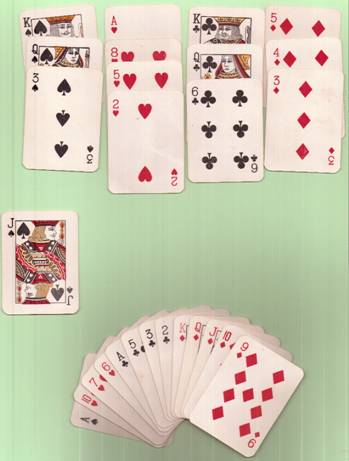

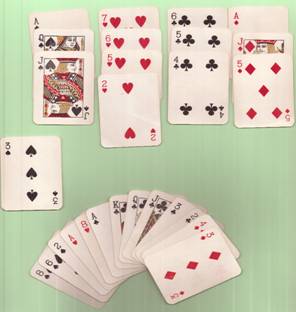
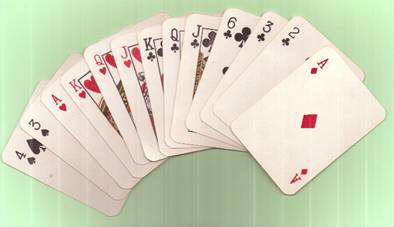
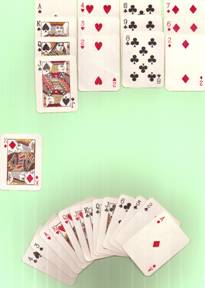
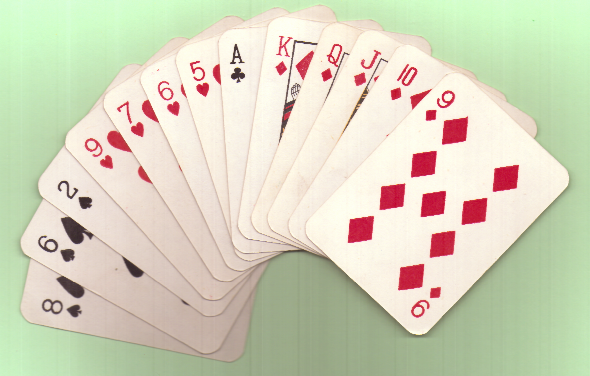
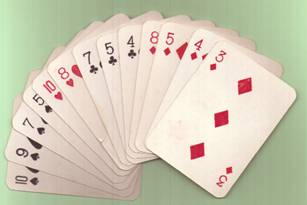
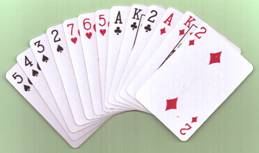
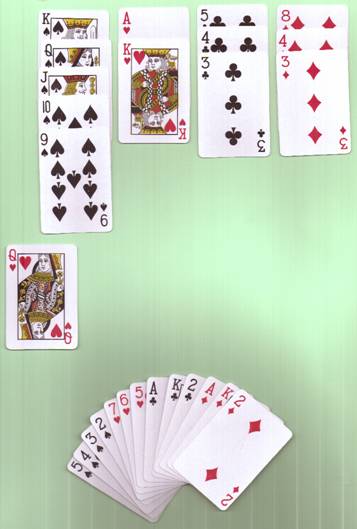

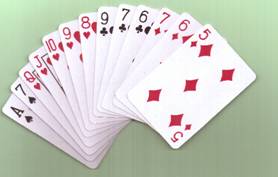
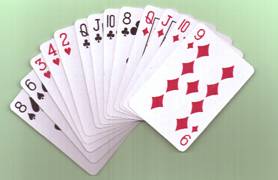
7)SOME USEFUL ADVICE ON CARD PLAY, PART 1
A)How can we make as many tricks as possible?
There are five main methods to make tricks:
1)Play winners
What are “winners”? They are the cards that cannot be beaten.
Take this hand for example:
A)How can we make as many tricks as possible?
There are five main methods to make tricks:
1)Play winners
What are “winners”? They are the cards that cannot be beaten.
Take this hand for example:
If the contract is in No Trump, when you play the ¨A, you are sure to win. So the ¨A is called a “winner”. Likewise the ©A, ©K, ©Q, and ©J are also winners, as they cannot be beaten. So in total there are five winners in that hand. It means that if it is your turn to play, you are sure of five tricks.
If the contract is not in No Trump, it could be a different story. For example, if the contract is in diamonds, like 3D, we are only sure of one winner: the ¨A. We are not sure to have any winners in the heart suit, as it is possible that one of the two opponents may have no hearts at all, and could play a trump(diamond) on one of our big hearts.
If the contract is not in No Trump, it could be a different story. For example, if the contract is in diamonds, like 3D, we are only sure of one winner: the ¨A. We are not sure to have any winners in the heart suit, as it is possible that one of the two opponents may have no hearts at all, and could play a trump(diamond) on one of our big hearts.
2)Establish high cards
Sometimes to make as many tricks as possible, you have to start by losing a trick. Consider this set-up:
Sometimes to make as many tricks as possible, you have to start by losing a trick. Consider this set-up:
The hand at the bottom of the picture is yours.
You are South, the Declarer. The contract is 3NT.
Your left-side opponent, West, has made the opening lead: ªJ. Dummy(North) then spreads out all his cards.
How many winners have you? It is easy to count them, you have seven:
ªA, ªK, ªQ, ©A, §A, §K, §Q. So to make your 3NT contract, you need two more tricks. It looks like you could get them in the diamond suit, but unfortunately you are missing the Ace. Don’t worry, all you have to do is lose one trick in diamond early, in order to make many diamond tricks later.
So this is what you do:
.Trick 1: Play the ª3 from Dummy, East plays a small spade, and you win with the ªA.
.Trick 2: Play the ¨K from your hand. You know that you are not going to win the trick, but you want to get rid of the ¨A. You want to “establish” all your other diamonds as winners. So one of the two opponents plays the ¨A and you lose the trick.
.Trick 3: No matter which suit the opponents play, you are in control, as you have a winner in every suit: ªK, §A, ©A, ¨Q. So for example they play another spade. You win with the ªK in Dummy and play a little heart from your hand.
.Trick 4: play the ªQ, and a little heart from your hand.
.Trick 5: play a little diamond from Dummy. You have now in your hand four winners in the diamond suit, that have been established by the loss of trick 2. You win with ¨Q.
.Trick 6: Play ¨J and the last diamond in Dummy.
.Trick 7: Play ¨10 and a little heart in Dummy.
.Trick 8: Play ¨9 and a little heart in Dummy.
.Trick 9: Play ©10 and win with the Ace in Dummy.
.Trick 10: Play §K from Dummy and a little club from your hand.
That’s it! You have your nine tricks for your 3NT contract. Anything extra is now a bonus.
.Trick 11: Play §Q from Dummy and a little club from your hand.
.Trick 12: Play a little club from Dummy and win with the Ace in our hand. You have now eleven tricks.
.Trick 13: When you play your last club, one of the opponents wins with the §J, as he had a lot of clubs at the start.
So it pays to establish tricks with high cards.
You are South, the Declarer. The contract is 3NT.
Your left-side opponent, West, has made the opening lead: ªJ. Dummy(North) then spreads out all his cards.
How many winners have you? It is easy to count them, you have seven:
ªA, ªK, ªQ, ©A, §A, §K, §Q. So to make your 3NT contract, you need two more tricks. It looks like you could get them in the diamond suit, but unfortunately you are missing the Ace. Don’t worry, all you have to do is lose one trick in diamond early, in order to make many diamond tricks later.
So this is what you do:
.Trick 1: Play the ª3 from Dummy, East plays a small spade, and you win with the ªA.
.Trick 2: Play the ¨K from your hand. You know that you are not going to win the trick, but you want to get rid of the ¨A. You want to “establish” all your other diamonds as winners. So one of the two opponents plays the ¨A and you lose the trick.
.Trick 3: No matter which suit the opponents play, you are in control, as you have a winner in every suit: ªK, §A, ©A, ¨Q. So for example they play another spade. You win with the ªK in Dummy and play a little heart from your hand.
.Trick 4: play the ªQ, and a little heart from your hand.
.Trick 5: play a little diamond from Dummy. You have now in your hand four winners in the diamond suit, that have been established by the loss of trick 2. You win with ¨Q.
.Trick 6: Play ¨J and the last diamond in Dummy.
.Trick 7: Play ¨10 and a little heart in Dummy.
.Trick 8: Play ¨9 and a little heart in Dummy.
.Trick 9: Play ©10 and win with the Ace in Dummy.
.Trick 10: Play §K from Dummy and a little club from your hand.
That’s it! You have your nine tricks for your 3NT contract. Anything extra is now a bonus.
.Trick 11: Play §Q from Dummy and a little club from your hand.
.Trick 12: Play a little club from Dummy and win with the Ace in our hand. You have now eleven tricks.
.Trick 13: When you play your last club, one of the opponents wins with the §J, as he had a lot of clubs at the start.
So it pays to establish tricks with high cards.
3)Establish small cards from long suits
Consider this set-up:
Consider this set-up:
The hand at the bottom of the picture is yours.
You are South, the Declarer. The contract is 3NT.
Your left-side opponent, West, has made the opening lead: ©K. Dummy(North) then spreads out all his cards.
How many winners have you? It is easy to count them, you have seven:
ªA, ©A, ¨A, §A, §K, §Q, §J. So to make your 3NT contract, you need two more tricks. It looks like you will get them in the club suit.
How many clubs have you between yourself and Dummy? Nine.
So how many clubs do the two opponents have between them? Four , which is the difference between thirteen and nine. So if you play your four winners in the club suit, you are certain that the opponents will have no clubs left, and the two little darlings §3 and §2 will give you two more tricks! Those two little cards will be “established” as tricks. So this is what you do:
Trick 1: Play a small heart from Dummy. East plays a small heart, and you win with the ©A in your hand.
Tricks 2, 3, 4, 5: You win the four tricks with your four big clubs. On trick 5, when Dummy has no club left, you play a little heart from Dummy. It doesn’t matter what the opponents play on the four tricks.
Trick 6: Play the §3, a winner! (and a little heart in Dummy)
Trick 7: Play the §2, another winner! (and a little heart in Dummy)
Trick 8: Play a little spade from your hand and win in Dummy with ªA
Trick 9: Play the ¨A from Dummy and a little diamond from your hand.
It really doesn’t matter what the opponents played on the last four tricks, you have now made nine tricks and the 3NT contract is made!
Tricks 10, 11, 12, 13: the opponents will surely make those four tricks with their three kings and one of their queens.
You are South, the Declarer. The contract is 3NT.
Your left-side opponent, West, has made the opening lead: ©K. Dummy(North) then spreads out all his cards.
How many winners have you? It is easy to count them, you have seven:
ªA, ©A, ¨A, §A, §K, §Q, §J. So to make your 3NT contract, you need two more tricks. It looks like you will get them in the club suit.
How many clubs have you between yourself and Dummy? Nine.
So how many clubs do the two opponents have between them? Four , which is the difference between thirteen and nine. So if you play your four winners in the club suit, you are certain that the opponents will have no clubs left, and the two little darlings §3 and §2 will give you two more tricks! Those two little cards will be “established” as tricks. So this is what you do:
Trick 1: Play a small heart from Dummy. East plays a small heart, and you win with the ©A in your hand.
Tricks 2, 3, 4, 5: You win the four tricks with your four big clubs. On trick 5, when Dummy has no club left, you play a little heart from Dummy. It doesn’t matter what the opponents play on the four tricks.
Trick 6: Play the §3, a winner! (and a little heart in Dummy)
Trick 7: Play the §2, another winner! (and a little heart in Dummy)
Trick 8: Play a little spade from your hand and win in Dummy with ªA
Trick 9: Play the ¨A from Dummy and a little diamond from your hand.
It really doesn’t matter what the opponents played on the last four tricks, you have now made nine tricks and the 3NT contract is made!
Tricks 10, 11, 12, 13: the opponents will surely make those four tricks with their three kings and one of their queens.
4)Finessing
Consider this set-up:
Consider this set-up:
The hand at the bottom of the picture is yours(it is the same hand as in the previous example).
You are South, the Declarer. The contract is 3NT.
Your left-side opponent, West, has made the opening lead: ª3.
Dummy(North) then spreads out all his cards(it is nearly the same hand as in the previous example, the only change being the ªQ for the ª4).
How many winners have you? It is easy to count them, you have nine:
ªA, ©A, ¨A, and six winners in the club suit, as we saw in the previous example. So in fact you are sure to make your contract!
But how about trying to make more than nine tricks? There is something you can try: instead of playing the ªA at trick 1, try playing the ªJ. If you are lucky, it will win the trick. That will happen if West has the ªK. And if East has the ªK, hard luck, you just lose trick 1, but you have no problems, as you still have the four aces to control each suit.
That particular way of playing, the ªJ instead of the ªA, is called “finessing”. You have a 50% chance of success, as the ªK has as good a chance of being with East as it has of being with West. You are “finessing” the ªK.
So this is what you do:
At trick 1: play the ªJ from Dummy and a little spade from your hand.
.If East has the ªK, he wins the trick. Then, no matter what he plays next, you have ten winners, the nine winners as above, and also the ªQ.
.If West has the ªK, Dummy wins the trick. At trick 2: play a club from Dummy and you win in your hand with the §A. Then at trick 3, now is the time to finesse the ªK again! Play a spade from your hand and look at the card West plays. If he plays the ªK, you win with the ªA, and if he plays a little spade, you play the ªQ to win an extra-trick! So you have eleven tricks in the end.
You are South, the Declarer. The contract is 3NT.
Your left-side opponent, West, has made the opening lead: ª3.
Dummy(North) then spreads out all his cards(it is nearly the same hand as in the previous example, the only change being the ªQ for the ª4).
How many winners have you? It is easy to count them, you have nine:
ªA, ©A, ¨A, and six winners in the club suit, as we saw in the previous example. So in fact you are sure to make your contract!
But how about trying to make more than nine tricks? There is something you can try: instead of playing the ªA at trick 1, try playing the ªJ. If you are lucky, it will win the trick. That will happen if West has the ªK. And if East has the ªK, hard luck, you just lose trick 1, but you have no problems, as you still have the four aces to control each suit.
That particular way of playing, the ªJ instead of the ªA, is called “finessing”. You have a 50% chance of success, as the ªK has as good a chance of being with East as it has of being with West. You are “finessing” the ªK.
So this is what you do:
At trick 1: play the ªJ from Dummy and a little spade from your hand.
.If East has the ªK, he wins the trick. Then, no matter what he plays next, you have ten winners, the nine winners as above, and also the ªQ.
.If West has the ªK, Dummy wins the trick. At trick 2: play a club from Dummy and you win in your hand with the §A. Then at trick 3, now is the time to finesse the ªK again! Play a spade from your hand and look at the card West plays. If he plays the ªK, you win with the ªA, and if he plays a little spade, you play the ªQ to win an extra-trick! So you have eleven tricks in the end.
5)Ruffing
Consider this set-up:
Consider this set-up:

The hand at the bottom of the picture is yours.
You are South, the Declarer. The contract is 5C.
Your left-side opponent, West, has made the opening lead: ¨A.
Dummy(North) then spreads out all his cards.
How many winners have you? It looks like you have eight: five in clubs,
ªA, ©A and ©K. So you need to find three more tricks. If you look at Dummy’s cards, you will notice that he has no diamonds, so you can win the first trick by playing a trump from Dummy. That is called “ruffing”. In fact if you play your cards right, you could use the three trumps in Dummy to ruff the three little diamonds in your hand, in this way getting the three extra-tricks that you need. So this is what you do:
Trick 1: play the §7 from Dummy and a little diamond from your hand.
Trick 2: play the ªA from Dummy and a little spade from your hand.
Trick 3: play a little heart from Dummy and win with the ©K.
Trick 4: play a little diamond from your hand and you get your second “ruff” with the §8.
Trick 5: play a little heart from Dummy, and win with the ©A.
Trick 6: play your last diamond and get your third ruff with the §9.
You have now made six tricks, and nobody will prevent you from making five more tricks with the five top trumps in your hand: §A, §K, §Q, §J and §10. So you have eleven tricks in total, and your contract.
B)To play or not to play winners first?
Beginners often wonder if it is a good idea to play all the winners first, to get as many tricks as possible early in the game. Sometimes it is, sometimes it isn’t. Let’s see two examples:
EXAMPLE 1 (Where it is a good idea to play your winners first)
You are South and you pick up this hand:
You are South, the Declarer. The contract is 5C.
Your left-side opponent, West, has made the opening lead: ¨A.
Dummy(North) then spreads out all his cards.
How many winners have you? It looks like you have eight: five in clubs,
ªA, ©A and ©K. So you need to find three more tricks. If you look at Dummy’s cards, you will notice that he has no diamonds, so you can win the first trick by playing a trump from Dummy. That is called “ruffing”. In fact if you play your cards right, you could use the three trumps in Dummy to ruff the three little diamonds in your hand, in this way getting the three extra-tricks that you need. So this is what you do:
Trick 1: play the §7 from Dummy and a little diamond from your hand.
Trick 2: play the ªA from Dummy and a little spade from your hand.
Trick 3: play a little heart from Dummy and win with the ©K.
Trick 4: play a little diamond from your hand and you get your second “ruff” with the §8.
Trick 5: play a little heart from Dummy, and win with the ©A.
Trick 6: play your last diamond and get your third ruff with the §9.
You have now made six tricks, and nobody will prevent you from making five more tricks with the five top trumps in your hand: §A, §K, §Q, §J and §10. So you have eleven tricks in total, and your contract.
B)To play or not to play winners first?
Beginners often wonder if it is a good idea to play all the winners first, to get as many tricks as possible early in the game. Sometimes it is, sometimes it isn’t. Let’s see two examples:
EXAMPLE 1 (Where it is a good idea to play your winners first)
You are South and you pick up this hand:
As you also happen to be the Dealer of the cards, you open the bidding with 1C, to show your long suit, the one you think would be a good trump suit. Your left-hand side opponent(West) passes, and your partner(North) bids 1S. Your right-hand opponent(East) passes and it is your turn again. After a few seconds you decide to bid 3NT, to try to get a good score. The other three players pass after that. The bidding is over. You are Declarer and you have to make at least nine tricks.
West makes the opening lead: ¨K, and your partner(Dummy) spreads out all his cards on the table. It looks like this from the South point of view:
West makes the opening lead: ¨K, and your partner(Dummy) spreads out all his cards on the table. It looks like this from the South point of view:
.Trick 1 is straightforward: you play a small diamond from dummy and you win with the Ace in your hand. Now what should you do? Should you play all your winners first or not?
a)if you decide to play all your winners first
.Trick 2 you play ©A from your hand and a little heart from Dummy
.Trick 3 you play ©K from your hand and a little heart from Dummy
.Trick 4 you play ©Q from your hand and the last heart from Dummy
.Trick 5 you play ©J from your hand and a little diamond from Dummy.
You have already made five tricks and this is how things look:
a)if you decide to play all your winners first
.Trick 2 you play ©A from your hand and a little heart from Dummy
.Trick 3 you play ©K from your hand and a little heart from Dummy
.Trick 4 you play ©Q from your hand and the last heart from Dummy
.Trick 5 you play ©J from your hand and a little diamond from Dummy.
You have already made five tricks and this is how things look:
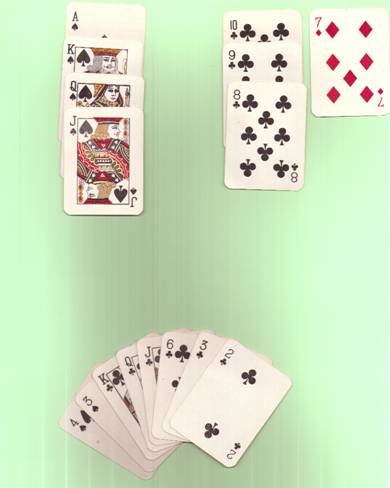
To stick to your idea of playing winners first, you now play at
.Trick 6 the ª3 from your hand and Dummy wins with the ªA
.Trick 7 Dummy plays the ªK and you play the ª4 in your hand
.Trick 8 Dummy plays the ªQ and you play a small club
.Trick 9 Dummy plays the ªJ and you play a small club
You have made nine tricks so far. The contract is made! Not bad at all. Any extra-trick will be a bonus.
Now you are looking at this, and Dummy is to play:
.Trick 6 the ª3 from your hand and Dummy wins with the ªA
.Trick 7 Dummy plays the ªK and you play the ª4 in your hand
.Trick 8 Dummy plays the ªQ and you play a small club
.Trick 9 Dummy plays the ªJ and you play a small club
You have made nine tricks so far. The contract is made! Not bad at all. Any extra-trick will be a bonus.
Now you are looking at this, and Dummy is to play:
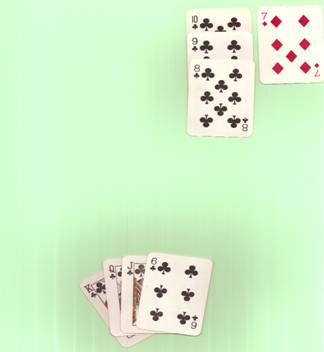
.Trick 10 Dummy plays a club, you play the §K, but West wins with §A
.Trick 11 West plays ¨Q and wins the trick
.Trick 12 West plays ¨J and wins the trick
.Trick 13 West plays ¨10 and wins the final trick
So in total you have made nine tricks and East-West made four. The contract is “just made”.
This was West’s hand at the beginning of the game:
.Trick 11 West plays ¨Q and wins the trick
.Trick 12 West plays ¨J and wins the trick
.Trick 13 West plays ¨10 and wins the final trick
So in total you have made nine tricks and East-West made four. The contract is “just made”.
This was West’s hand at the beginning of the game:
And this was East’s hand at the beginning of the game:
b)if you decide not to play your winners first
You remember that you won trick 1 in your hand with ¨A. You could decide to play the §K, to lose trick 2 as obviously the opponents have the §A, hoping to make a lot of tricks later on with the §Q, the §J, etc…
.Trick 2 You play the §K, and West wins with the §A
But now look at what happens next:
.Trick 3 West plays ¨Q and wins the trick
.Trick 4 West plays ¨J and wins the trick
.Trick 5 West plays ¨10 and wins the trick
.Trick 6 West plays ¨9 and wins the trick
Which means that unfortunately you have already lost five tricks! Your 3NT contract is beaten because you will not get nine tricks. Nevertheless you must continue playing. For example West plays the ©5, and now you win seven tricks with ©A, ©K, ©Q, ©J, and then ªA, ªK and ªQ. You only made eight tricks in total and you are “down 1”.
Does it mean it is always better to play your winners first? Let’s see:
EXAMPLE 2 (Where it is a good idea not to play your winners first)
You are South and you pick up this hand:
You remember that you won trick 1 in your hand with ¨A. You could decide to play the §K, to lose trick 2 as obviously the opponents have the §A, hoping to make a lot of tricks later on with the §Q, the §J, etc…
.Trick 2 You play the §K, and West wins with the §A
But now look at what happens next:
.Trick 3 West plays ¨Q and wins the trick
.Trick 4 West plays ¨J and wins the trick
.Trick 5 West plays ¨10 and wins the trick
.Trick 6 West plays ¨9 and wins the trick
Which means that unfortunately you have already lost five tricks! Your 3NT contract is beaten because you will not get nine tricks. Nevertheless you must continue playing. For example West plays the ©5, and now you win seven tricks with ©A, ©K, ©Q, ©J, and then ªA, ªK and ªQ. You only made eight tricks in total and you are “down 1”.
Does it mean it is always better to play your winners first? Let’s see:
EXAMPLE 2 (Where it is a good idea not to play your winners first)
You are South and you pick up this hand:
As you happen to be the Dealer, you decide to open the bidding with 1NT, as there is not one particularly long suit you would like as trump. West passes. Your partner, North bids 2S. East passes. You think for a while and bid 3NT. You are not too sure if it is the best bid, but if you make at least nine tricks, you will get a good score. The other three players pass after that. West makes the opening lead: ©Q, and this is what you see when Dummy(North) puts his cards down:
.Trick 1 is straightforward: you win with the ©A from Dummy and play a small heart from your hand. Now what should you do? Should you play all your winners first or not?
a)if you decide to play all your winners first
.Trick 2 you play the ©K
.Trick 3 you play a small club from Dummy and win with §A
.Trick 4 you play the §K
.Trick 5 you play the ¨A
.Trick 6 you play the ¨K
You have made six tricks so far, and this is what you are looking at:
a)if you decide to play all your winners first
.Trick 2 you play the ©K
.Trick 3 you play a small club from Dummy and win with §A
.Trick 4 you play the §K
.Trick 5 you play the ¨A
.Trick 6 you play the ¨K
You have made six tricks so far, and this is what you are looking at:
Your best bet for a few more tricks is now in the spade suit, so at
.Trick 7 you play a small spade from your hand. West plays the ªA, you play the ª9 from Dummy, and East plays a small spade. That trick is for East-West. Unfortunately look at what happens now:
.Trick 8 West plays the ©J and wins the trick
.Trick 9 West plays the ©10 and wins the trick
.Trick 10 West plays the © 9 and wins the trick
.Trick 11 West plays a small club and East wins the trick with the §Q
.Trick 12 East plays the ¨Q and wins the trick
.Trick 13 East plays the ¨J and wins the trick
So in the end you only made six tricks. You are “down 3”.
This was West’s hand in the beginning:
.Trick 7 you play a small spade from your hand. West plays the ªA, you play the ª9 from Dummy, and East plays a small spade. That trick is for East-West. Unfortunately look at what happens now:
.Trick 8 West plays the ©J and wins the trick
.Trick 9 West plays the ©10 and wins the trick
.Trick 10 West plays the © 9 and wins the trick
.Trick 11 West plays a small club and East wins the trick with the §Q
.Trick 12 East plays the ¨Q and wins the trick
.Trick 13 East plays the ¨J and wins the trick
So in the end you only made six tricks. You are “down 3”.
This was West’s hand in the beginning:
And this was East’s hand in the beginning:
b)if you decide not to play your winners first
You remember that you won trick 1 with the ©A in Dummy.
So you could decide to do this:
.Trick 2 you play the ªK from Dummy, East plays a small spade, you play a small spade from your hand, and West wins the trick with ªA
.Trick 3 West plays the ©8. You win in Dummy with ©K
.Trick 4 Dummy plays the ªQ and wins the trick
.Trick 5 Dummy plays the ªJ and wins the trick
.Trick 6 Dummy plays the ª10 and wins the trick
.Trick 7 Dummy plays the ª9 and wins the trick
.Trick 8 Dummy plays a small club and you win the trick with §A
.Trick 9 You play the §K and win the trick
.Trick 10 You play the ¨A and win the trick
.Trick 11 You play the ¨K and win the trick
You have already made ten tricks, one more than necessary. Good!
.Trick 12 You play a small club, and East wins with the §Q
.Trick 13 East plays the ¨Q and wins the trick
So, in that example, it was better not to play all the winners first.
So how do we know what to do in each case? There is no fast rule. However the experience of the champions has shown that in the vast majority of cases it is not a good idea to play all the winners first. The more you play, the more you will find that true.
You remember that you won trick 1 with the ©A in Dummy.
So you could decide to do this:
.Trick 2 you play the ªK from Dummy, East plays a small spade, you play a small spade from your hand, and West wins the trick with ªA
.Trick 3 West plays the ©8. You win in Dummy with ©K
.Trick 4 Dummy plays the ªQ and wins the trick
.Trick 5 Dummy plays the ªJ and wins the trick
.Trick 6 Dummy plays the ª10 and wins the trick
.Trick 7 Dummy plays the ª9 and wins the trick
.Trick 8 Dummy plays a small club and you win the trick with §A
.Trick 9 You play the §K and win the trick
.Trick 10 You play the ¨A and win the trick
.Trick 11 You play the ¨K and win the trick
You have already made ten tricks, one more than necessary. Good!
.Trick 12 You play a small club, and East wins with the §Q
.Trick 13 East plays the ¨Q and wins the trick
So, in that example, it was better not to play all the winners first.
So how do we know what to do in each case? There is no fast rule. However the experience of the champions has shown that in the vast majority of cases it is not a good idea to play all the winners first. The more you play, the more you will find that true.





